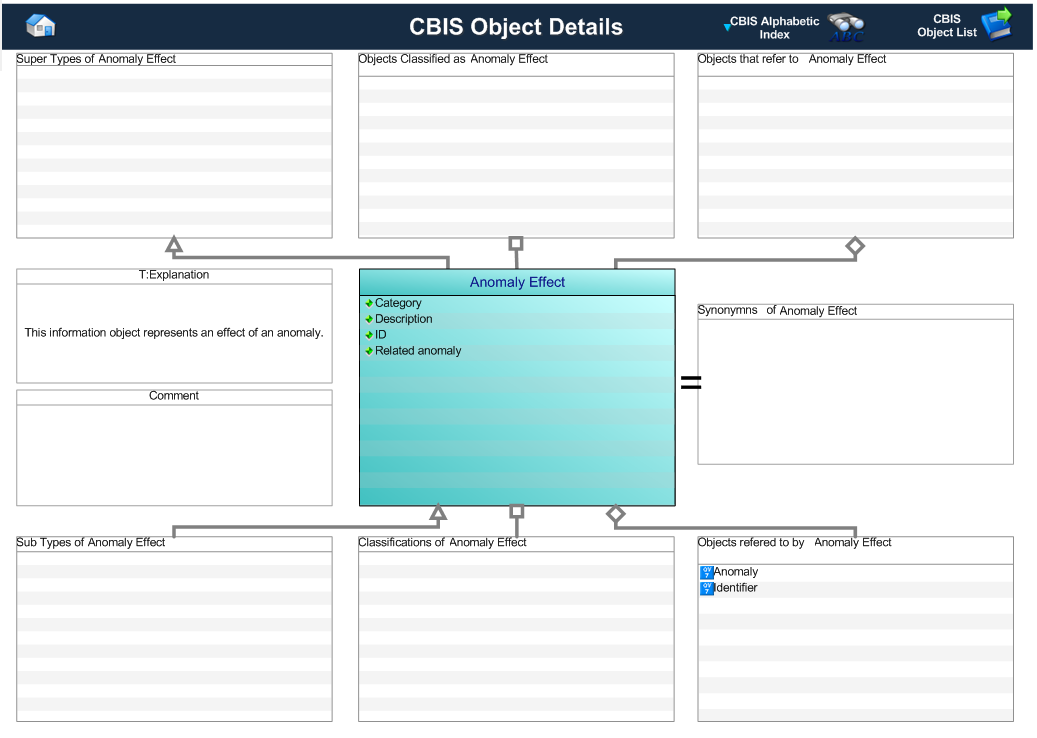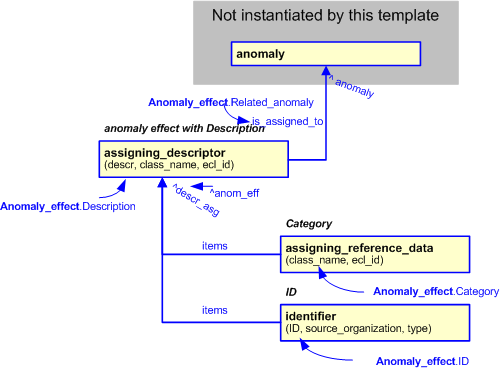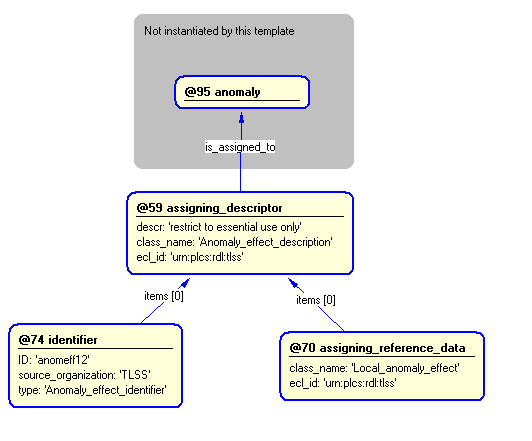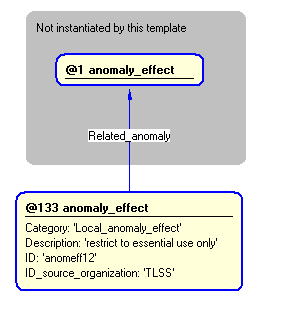Template:— anomaly_effect (anom_eff)
Context:— UK_Defence |
Date: 2009/04/17 10:10:53
Revision: 1.2
|
This section specifies the template anomaly_effect.
NOTE
The template has been defined in the context of
UK_Defence.
Refer to the business context for details of related templates.
NOTE
An explanation of a template and the associated instantiation path is
provided in the
Template overview
section.
This template describes how to represent the UK_Defence concept of an anomaly effect
in terms of PLCS model elements (templates, entities, and reference data).
This template describes how to represent UK_Defence anomaly using
State_assessment
This information object represents an effect of an anomaly.
Figure 1 — Graphical Representation for Business Object Anomaly Effect
Anomaly Effect
The definition of a anomaly effect object is:
This information object represents an effect of an anomaly.
|
Attribute name
|
Attribute description
|
Attribute type
|
Optionality
|
| Category |
This is the category of the anomaly effect.
EXAMPLE:
The categories include:
1 - "local effect":
The effects local to the anomaly on the relating product, to include:
(a) Evidence, if any, that the anomaly has occurred, or is in the process of occurring, including reduced levels of performance,
and covering failure detection methods (such as alarms, built-in-test indications).
(b) Whether a standby system can provide the function of the failed product.
2 - "next higher effect":
The effects of the anomaly on the product of which the relating product forms a part, to include:
(a) Potential physical damage to the product.
(b) Potential secondary effects to provide an account of any secondary damage to either other products in the system or unrelated
products/systems in the vicinity.
3 - "end effect":
The effects of the anomaly on the end item or platform of which the relating product forms a part, to include:
(a) Ways in which the anomaly may affect the operational, functional or status of the end item or platform.
4 - "environmental effect":
The effects of the anomaly on the environment.
5 - "operational effect" (including whether an immediate shutdown was required):
The effects of the anomaly on the operational requirement (e.g. mission).
6 - "non operational effect"
The effects of the anomaly that do not relate to the operational requirement (e.g. mission).
7 - "safety effect":
The effects of the anomaly relating to human and or equipment safety.
8 - "noise effect":
The effects of the anomaly relating to noise signatures (particularly important for submarines)
Attribute Type
|
Intrinsic |
Mandatory |
| Description |
This is the description of the anomaly effect. |
Intrinsic |
Mandatory |
| ID |
This is the identifier of the anomaly effect, including who defined it and when. |
Identifier |
Mandatory |
| Related anomaly |
This is the reference to the type of failure of which this anomaly may be an occurrence. |
Anomaly |
Mandatory |
Table 1 — Anomaly attribute details
The EXPRESS-G diagram in
Figure
2
shows the templates and EXPRESS entities that are required
to represent the template
"anomaly_effect".
The text highlighted in blue shows the template parameters.
Figure 2 — An EXPRESS-G representation of the Information model for anomaly_effect
The graphic for the template to be used in other EXPRESS-G diagrams
is shown in Figure
3
below.
Figure 3 — The graphical representation of the anomaly_effect template
The following input parameters are defined for this template:
This is the category of the anomaly effect.
The following classes and their sub-classes can be used:
classifications: [Anomaly_effect_with_defined_category]![[warning:]](../../../../../../images/dex/warning.gif) Error RDL4: The URI urn:plcs:rdl:uk_defence is not listed in dexlib/data/refdata/rdl_index.xml
Error RDL4: The URI urn:plcs:rdl:uk_defence is not listed in dexlib/data/refdata/rdl_index.xml
This is the description of the anomaly effect.
This is the identifier of the anomaly effect.
The organization that created the associated identifier. Additionally
a Person or Information System could be defined when either of these are the source; see Identifier template characterizations
This is the identifier of the anomaly effect.
The following reference parameters are defined for this template:
Allow the
Document_assignment
entity instantiated in this path to be referenced when this template is used.
%^target = $anomaly_effect.anom_eff%
The following parameter combinations specify a uniqueness constraint:
Unique constraint: Unique anomaly_effect
Each instance of the
entity
(
Document_assignment)
within the data set shall be uniquely identified
by a combination of the following parameters on this
template (anomaly_effect) namely:
ID,
Related_anomaly.
The
instance is
referenced by the following template parameter:
anom_eff.
The instantiation path shown below specifies the entities that are to be
instantiated by the template.
A description of templates and the syntax for the instantiation path is
provided in the
Templates Help/Information section.
/
assigning_descriptor(
descr=@Description,
class_name='Anomaly_effect_description',
ecl_id='urn:plcs:rdl:uk_defence',
is_assigned_to=@Related_anomaly)/
%^anom_eff = $assigning_descriptor.descr_asg%
/
assigning_reference_data(
items=^anom_eff,
class_name=@Category,
ecl_id='urn:plcs:rdl:uk_defence')/
/
identifier(
ID=@ID,
source_organization=@ID_source_organization,
type='Anomaly_effect_identifier',
items=^anom_eff)/
The instance diagram in Figure
4
shows an example of the EXPRESS entities and templates that are instantiated by the template:
/anomaly_effect(ID='anomeff12', ID_source_organization='UK_Defence', Description='restrict to essential use only', Category='Local_anomaly_effect', Related_anomaly='@1')/
(an illustration of the consolidated anomaly_effect template is shown in
Figure
5 below.)
Figure 4 — Entities instantiated by anomaly_effect template
The instance diagram in
Figure
5
shows the graphic symbol for the template that is to be
used in other instance diagrams. The example template is:
/anomaly_effect(ID='anomeff12', ID_source_organization='UK_Defence', Description='restrict to essential use only', Category='Local_anomaly_effect', Related_anomaly='@1')/
Figure 5 — Instantiation of anomaly_effect template
Characterizations
No common characterizations of the template
anomaly_effect
have been identified. However, the ISO 10303-239 EXPRESS model
may enable other assignments to the entities instantiated by the template.




